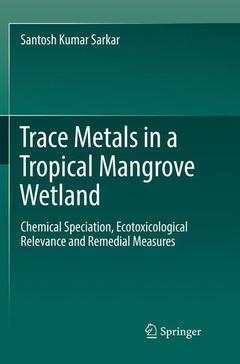Description
Trace Metals in a Tropical Mangrove Wetland , Softcover reprint of the original 1st ed. 2018
Chemical Speciation, Ecotoxicological Relevance and Remedial Measures
Author: Sarkar Santosh Kumar
Language: English
Subjects for Trace Metals in a Tropical Mangrove Wetland :
Keywords
Trace metals/metalloids; Acid-leachable metals; Chemical speciation of metals; Ecological risk; Geochemical fractionation; Phytoremediation; Sediment geochemistry; Sediment Quality Guidelines (SQGs); Sundarban mangrove wetland; marine and freshwater sciences; climate change impacts; ecotoxicology; water quality and water pollution
Approximative price 105.49 €
In Print (Delivery period: 15 days).
Add to cartPublication date: 08-2018
Support: Print on demand
Approximative price 105.49 €
In Print (Delivery period: 15 days).
Add to cartPublication date: 08-2017
Support: Print on demand
Description
/li>Contents
/li>Biography
/li>Comment
/li>
This book offers a comprehensive and accessible guide covering various aspects of trace metal contamination in abiotic and biotic matrices of an iconic Indian tropical mangrove wetland ? Sundarban. Divided into nine chapters, the book begins by discussing the fundamental concepts of sources, accumulation rate and significance of trace metal speciation, along with the impact of multiple stressors on trace metal accumulation, taking into account both tourist activities and the exacerbating role of climate change. The second chapter presents a detailed account of the sampling strategy and preservation of research samples, followed by exhaustive information on sediment quality assessment and ecological risk, instrumental techniques in environmental chemical analyses, quality assurance and quality control, along with the Sediment Quality Guidelines (SQGs). Using raw data, the sediment quality assessment indices (e.g., pollution load index, index of geoaccumulation, Nemerow Pollution Load Index etc.) and conventional statistical analyses are worked out and interpreted precisely, allowing students to readily evaluate and interpret them. This is followed by chapters devoted to trace metal accumulation in sediments and benthic organisms, as well as acid-leachable and geochemical fractionation of trace metals in sediments. The book then focuses on chemical speciation of butylin and arsenic in sediments as well as macrozoobenthos (polychaetous annelids). Finally, potential positive role of the dominant mangrove Avicennia in sequestering trace metals from rhizosediments of Sundarban Wetland is elaborately discussed. This timely reference book provides a versatile and in-depth account for understanding the emerging problems of trace metal contamination ? issues that are relevant for many countries around the globe.
Dr. Santosh Kumar Sarkar, Professor of Marine Science, University of Calcutta, has over 30 years of research experience in marine and estuarine ecology, biology and geochemistry. He has authored more than 70 peer-reviewed scientific articles and several book chapters and also edited a book. He has been the Principal Investigator for 12 national projects in India and 7 international collaborative research projects. He has engaged in collaborative research work with renowned research institutes around the globe, namely, the Institute Rudjer Boskovic, Croatia; University of Genoa and University of Milan, Italy ; IPIMAR/INRB IP, Portugal ; University of Edinburgh, British Geological Survey, UK; University of Wuppertal, Germany; CSIRO, Adelaide, Australia; Masaryk University, Czech Republic and Fluminense Federal University,Brazil. He published the book “Loricate Ciliate Tintinnids in a Tropical Mangrove Wetland: Diversity, Distribution and Impact of Climate Change” with Springer in 2014, as well as another book titled “Marine Organic Micropollutants: A Case Study of the Indian Sundarban Mangrove Wetland” with Springer (forthcoming).
Highlights trace metal contamination levels, bioavailability and toxicity in sediments and biota of Sundarban, an iconic tropical mangrove wetland
Quantifies chemical speciation of trace metals to predict their mobility and potential toxicity
Explores the possibility of reducing toxicity of trace metals by means of mangrove plants by phytoremediation technology




